Tutima Tempostopp Flyback Chronograph: A Moving Homage To The History Of Glashütte
The Tutima Tempostopp was one of my biggest Baselworld 2017 surprises, and, as I wrote in Give Me Five! 5 Fantastic Manufacture Chronographs From Baselworld 2017, had I not been in polite company I might have shed a few tears of joy upon seeing it.
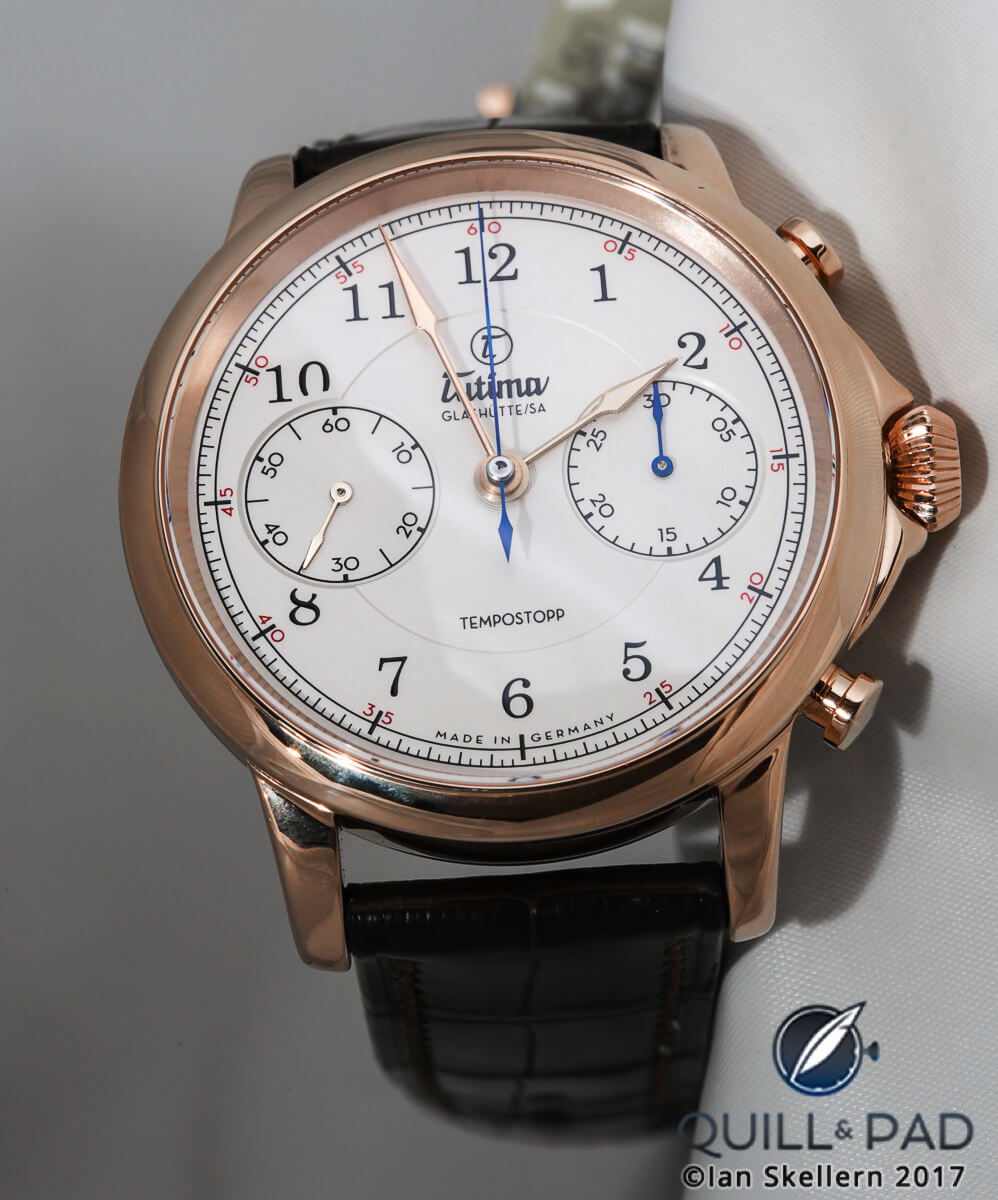
Tutima Tempostopp flyback chronograph
To understand this watch and what it means (and why I had such an emotional reaction) it might help if you understand some Glashütte history. So let’s start there.
In Glashütte, Germany at the start of 1927, a new group of companies best known by the initials Urofa-Ufag was founded under the management of Dr. Ernst Kurtz. Urofa-Ufag emerged from the economically crumbling Präzisions-Uhrenfabrik GmbH.
Kurtz, a jurist originally from Hamburg, helped create the legendary Glashütte watch factories Urofa (Uhren-Rohwerke-Fabrik Glashütte AG) and Ufag (Uhrenfabrik Glashütte AG). While Urofa concentrated more on manufacturing ébauches, Ufag produced finished watches.
This also marked the birth of Tutima, the leading brand of the newly founded conglomerate. Kurtz is therefore considered the founder of Tutima, which was originally a line created to encompass the company’s highest quality products.
With war on the minds of Europeans and a belated lesson learned in being too late to introduce new products – in this case the switch from pocket watches to wristwatches, which took place so late in Glashütte’s history that the town almost lost its source of income due to overwhelming competition from Switzerland – Glashütte began heavily concentrating on the manufacture of wristwatches.
As of 1938, Urofa and Ufag were appropriated as factories for defense manufacturing (as were so many other companies throughout Germany), and plans for pilot’s watches began to take shape using specific characteristics provided by the air force.
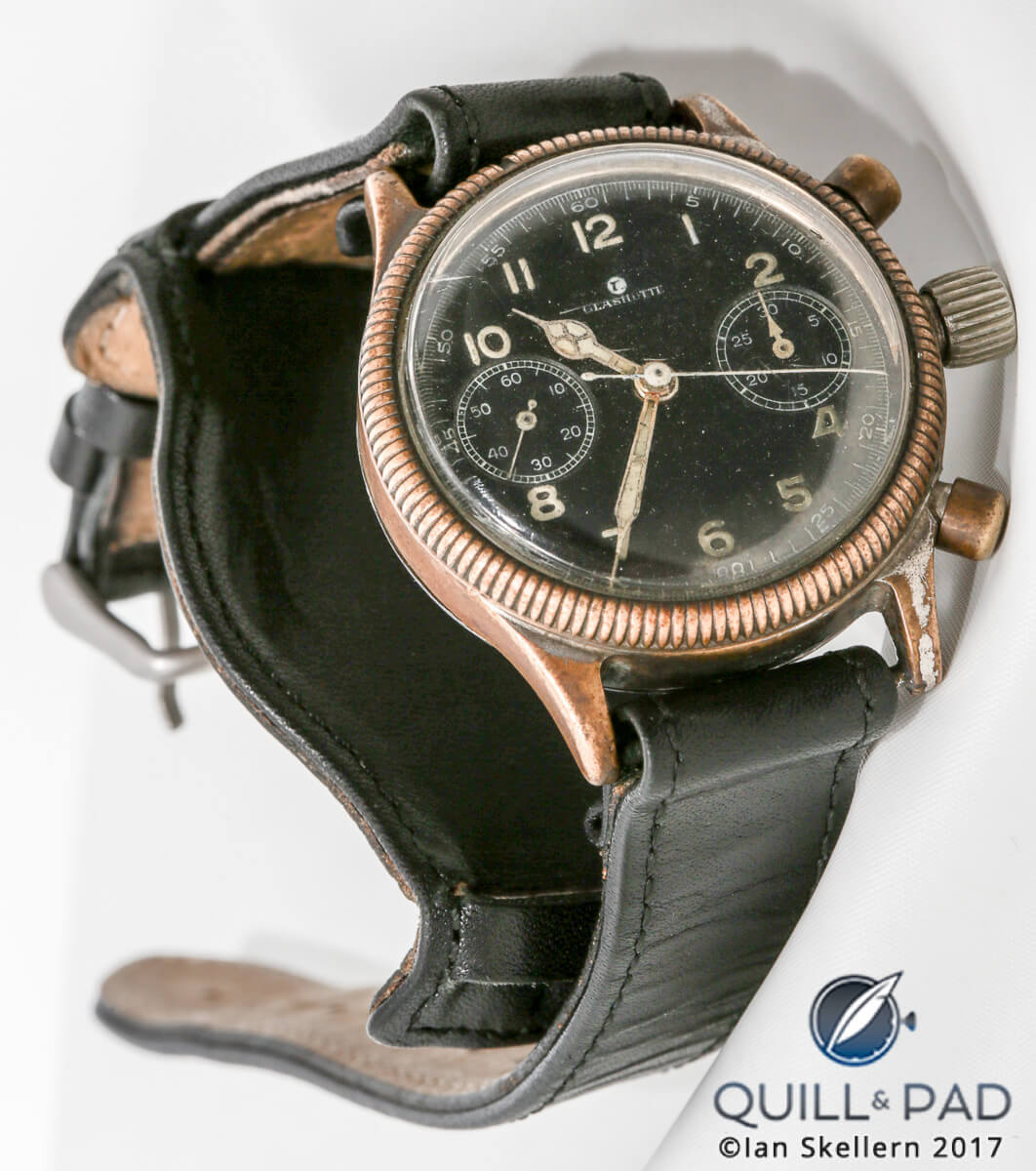
An original 1940s Tutima pilot’s chronograph powered by Urofa Caliber 59, which was the inspiration for Caliber T659 in the Tempostopp
Tutima would become most famous for a pilot’s watch known today as the original Tutima Glashütte pilot’s chronograph: this Glashütte classic boasted a striking fluted bezel featuring a conspicuous red reference marker on an extra-large fluted case outfitted with a very large crown, ergonomic chronograph buttons, and a large, legible dial featuring luminescent elements for great night-reading capability. It also featured a flyback function, which was known as a “tempostopp” in old German watch parlance.
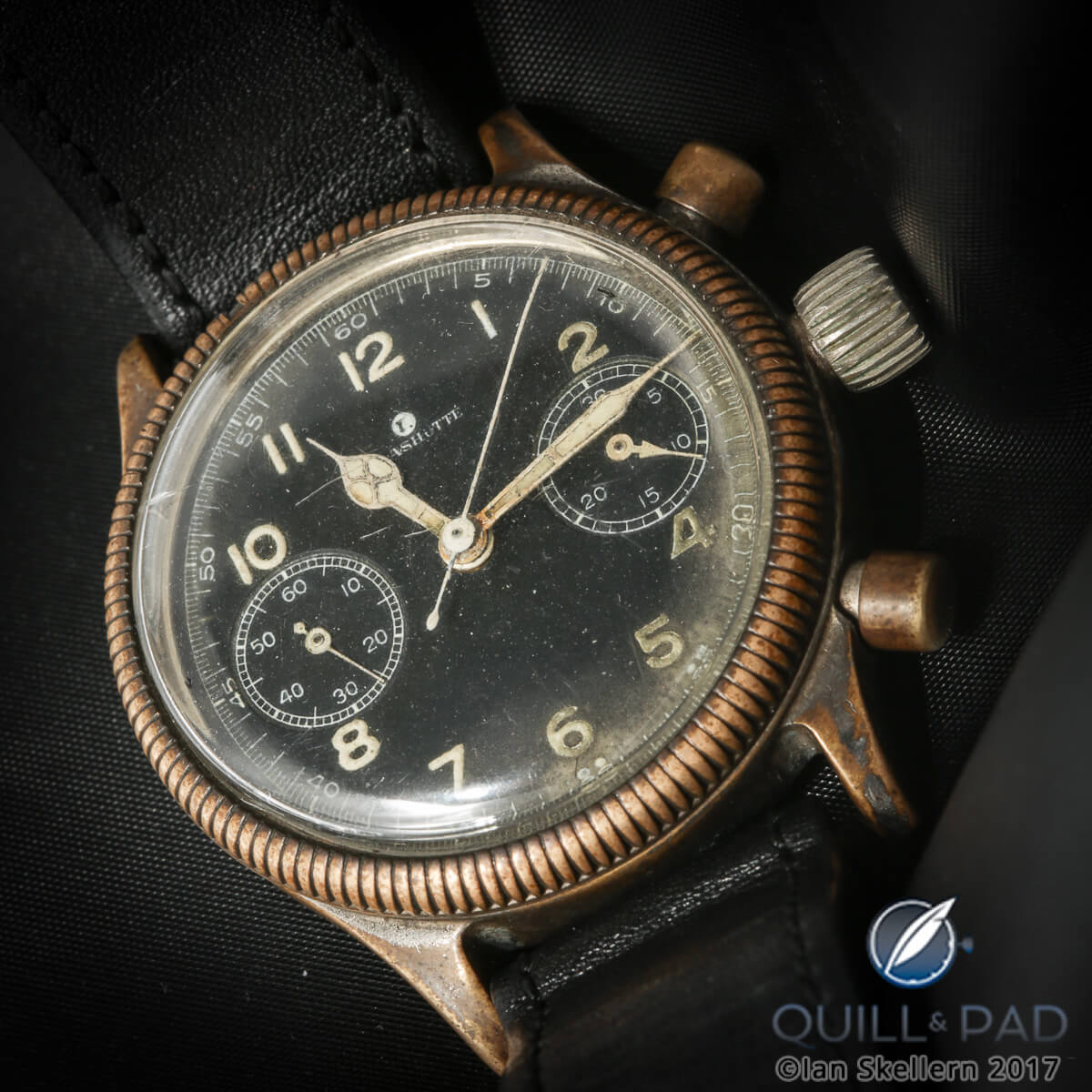
Original 1940s Tutima pilot’s chronograph
From 1941 through 1945, approximately 30,000 of these classics left the Glashütte workshops destined for pilots’ wrists, a number confirmed by author Kurt Herkner in his historical book, Glashütter Armbanduhren Band II. (Just as an aside, a view of the back of this watch graces the cover of that book.)
Urofa Caliber 59, a flyback chronograph movement
This pilot’s watch was outfitted with Urofa’s now-legendary chronograph Caliber 59, a movement created especially for it.
The manually wound column-wheel chronograph with a 30-minute counter was developed from 1939 to 1941 and remained in production until 1945.
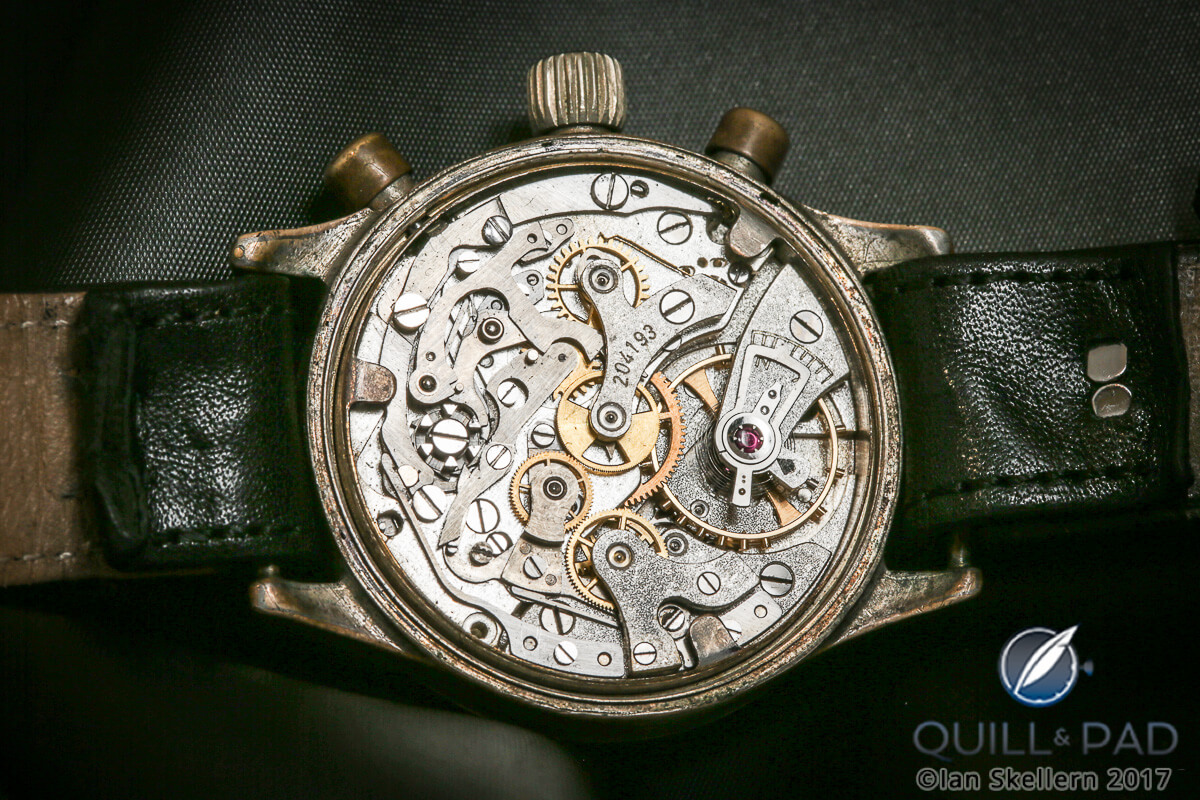
Urofa Caliber 59 in a 1940s Tutima pilot’s flyback chronograph
Caliber 59, the first German chronograph with flyback function, measured 34 mm in diameter and 5.4 mm in height and had 17 jewels. It boasted integrated column wheel control of the chronograph functions, a monometallic screw balance, and a Nivarox Breguet balance spring as well as shock protection.
Herkner’s book describes this movement’s wheels, pinions, and case as having been imported from Switzerland. Caliber 59 was only used for this one model and never sold to other manufacturers, though it was produced in three finishes: silver-plated frost covered with gold plate; silver-plated frost; and nickel plate.
On May 8, 1945, just scant hours before the official end of World War II, Glashütte was bombed one final time. The Russians made sure that all of the “military installations” located there were leveled.
Any factories that survived the attack from the air were dismantled and transported back to the Soviet Union, including the contents of Urofa and Ufag. Herkner describes in his book this taking place as of July 1, 1945. By August 8, the factories’ rooms were entirely empty.
All blueprints for Caliber 59 were lost.
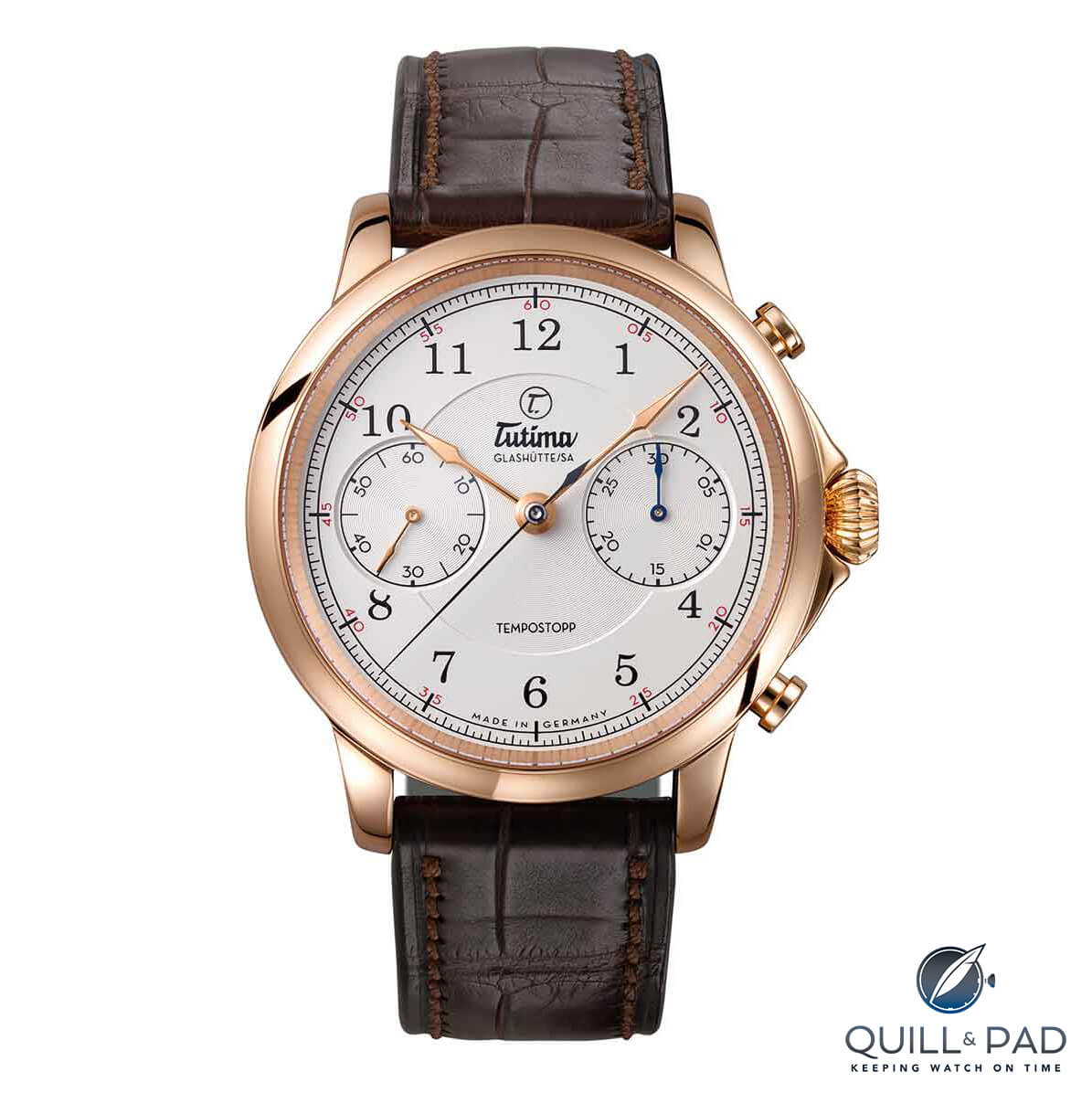
Tutima Tempostopp flyback chronograph
Tutima’s historical homage
I went to my Tutima Baselworld appointment fully unassuming and not knowing what I was about to see, however I am very glad it worked out that way because I could not have been more surprised!
In a year where Glashütte’s history had suffered a major loss with the passing of Walter Lange (see The Life And Times Of A. Lange & Söhne Re-Founder Walter Lange), I was profoundly glad to find this piece of Glashütte history so beautifully and lovingly resurrected.
The original Tutima Glashütte pilot’s chronograph is by far the most famous watch in Tutima’s 90-year history and indeed one of the most famous to emerge from Glashütte’s history; this is a watch that German-speaking collectors go to great lengths to acquire.
It more than makes sense for Tutima to have re-issued this watch at some point, but what I didn’t expect was to see it so soon – or in this luxurious and beautiful manner. As the original timepiece was a reliable pilot’s chronograph used in heavy-duty situations, I imagined that any re-issue would be faithful to that idea.
I was wrong about that, and I’m glad I was as this is simply an outstanding timepiece inside and out.
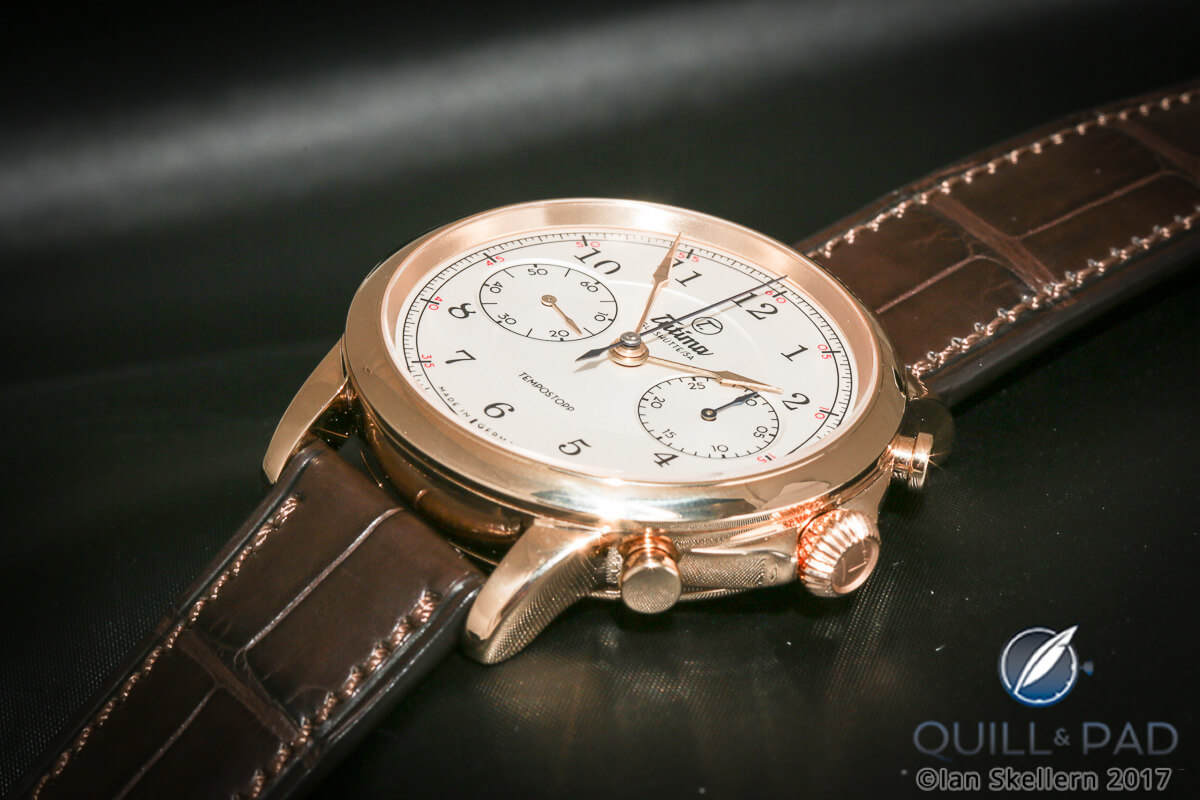
Tutima Tempostopp flyback chronograph
The new Tempostopp docks into Tutima’s luxury line, which already includes the Patria models and the lovely Hommage minute repeater of 2011, which was introduced the same day that Tutima announced it had returned to its home city, Glashütte, in May 2011.
The Hommage was the first minute repeater fully conceived, manufactured, and assembled on German soil.
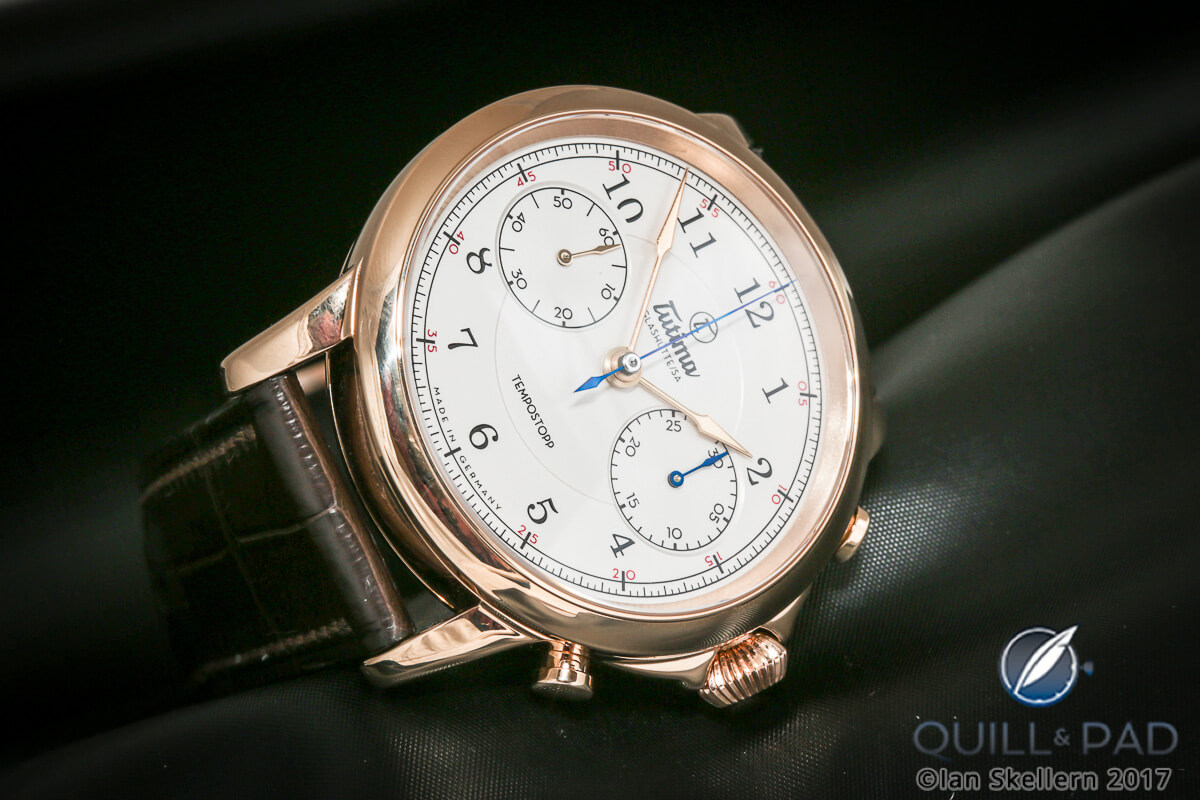
Tutima Tempostopp flyback chronograph
Tutima Caliber T659
The Tempostopp’s movement required three years’ worth of research and development before it was ready for use in this gorgeous watch. And it should be noted that all 236 components of this exquisite movement were designed, manufactured, and finished in Glashütte by Tutima.
Like Tutima’s Hommage minute repeater, the Tempostopp boasts eye-catching traditional matte frosted pink-gold-plated movement finish. But while the Hommage also identifies with its home through the use of a traditional three-quarter plate, the Tempostopp chooses to do that differently, proudly displaying its chronograph without the use of a top plate through the transparent case back.
And this is at least partially to show off the gorgeous chronograph components, which were engineered so that the architecture followed the 1940s pilot watch classic as closely as humanly possible.

Two integrated flyback chronographs: Urofa Caliber 59 from the 1940s (left) and the brand-new Tutima Caliber T659
This was quite a feat as Urofa Caliber 59’s plans remain lost to the sands of time and war-ravaged Saxony.
But while Tutima’s engineers were at it, they also used modern variations of some components to ensure longevity and reliability. However, notable elements that remain the same are the free-sprung Breguet hairspring, the column wheel-controlled chronograph, and the screw balance (though I doubt the original had gold screws like the Tempostopp).
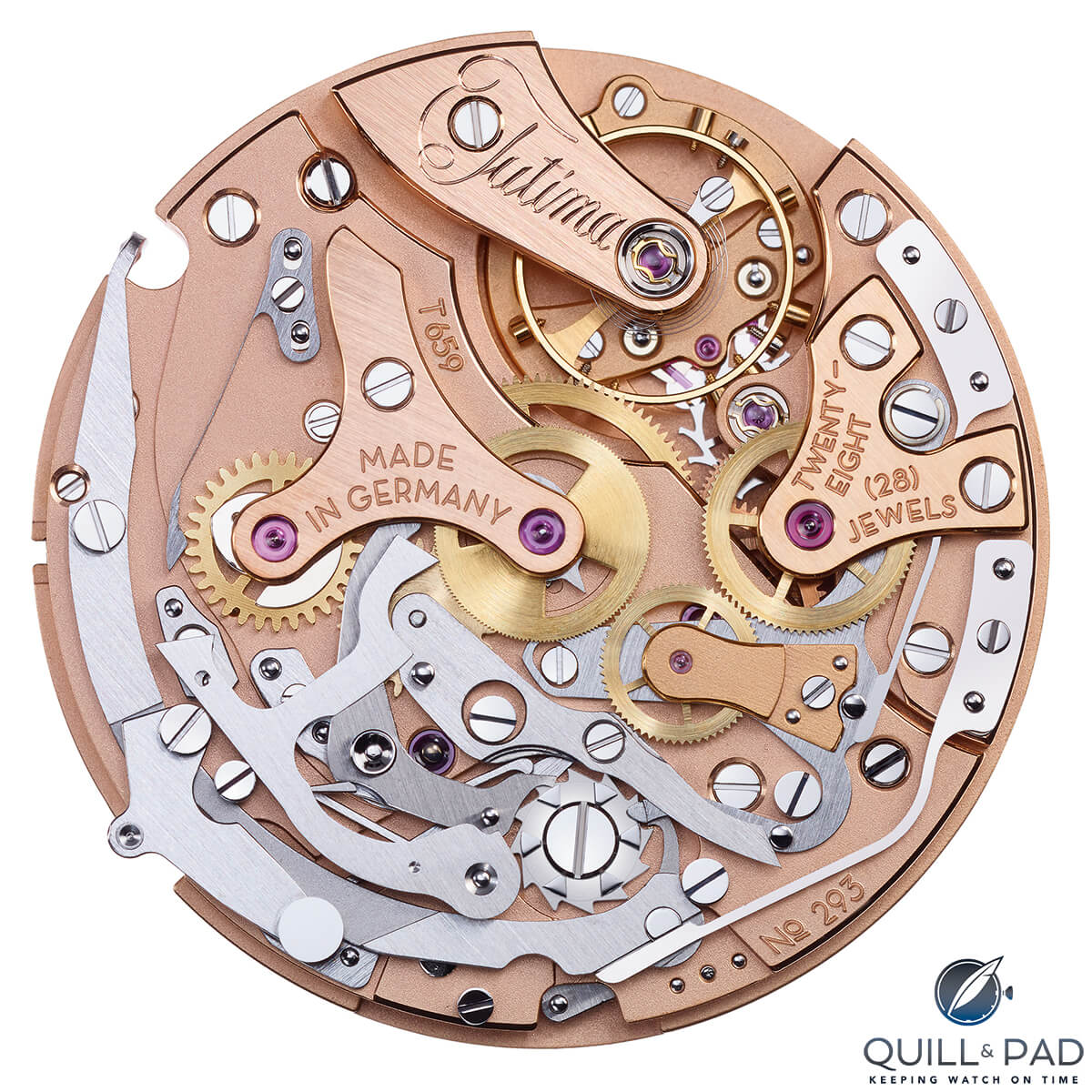
Tutima’s in-house Caliber T659 flyback chronograph movement, which powers the Tempostopp
While the original had only 17 jewels – a standard number for higher quality watches at the time – the Tempostopp boasts 28, though the diameter of the movement remains just about the same (34 mm in the original vs. 33.7 in the Tempostopp). The original movement’s height was 5.4 mm, while the Tempostopp’s Caliber T659 is 6.6 mm in height.
Both the old and new movements are outfitted with shock protection.
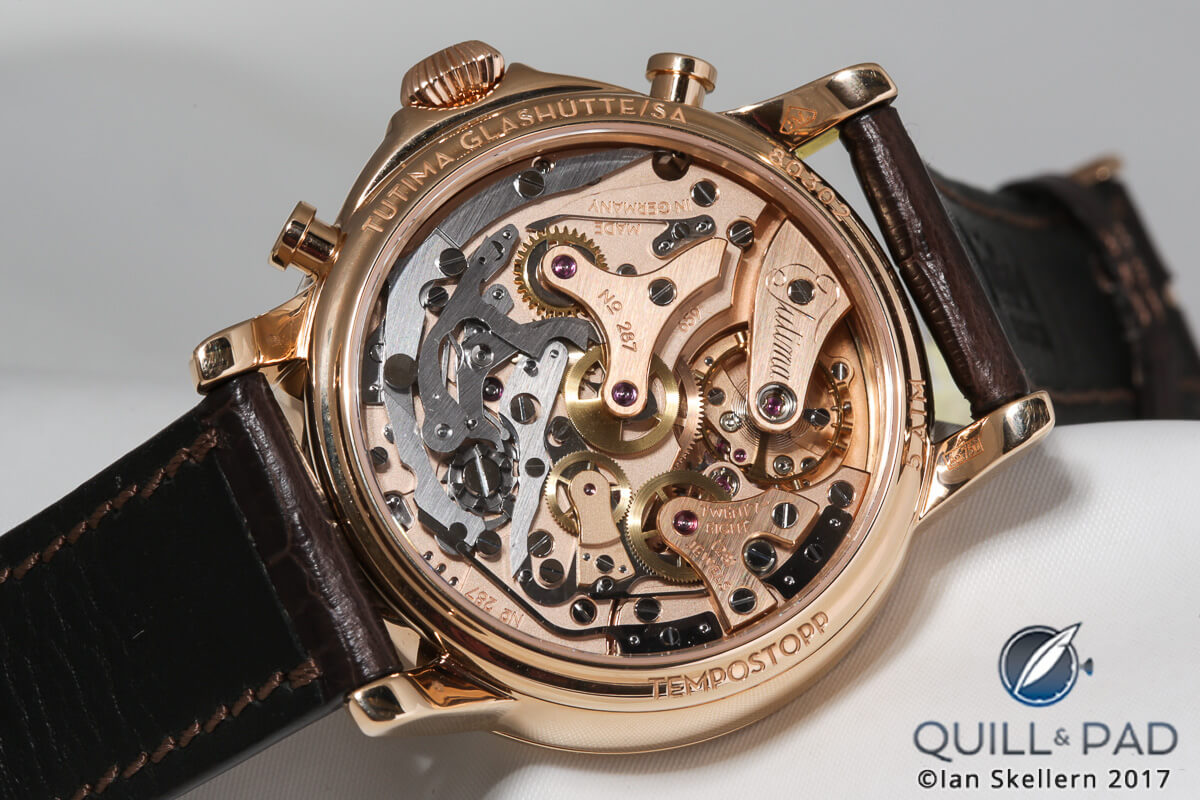
View through the display back to the beautiful in-house Tutima Caliber T659 flyback chronograph movement, which powers the Tempostopp
What is notably different in the Tempostopp from its inspiration is the high level of its finish. This includes a couple of special Glashütte elements: the balance cock is hand-engraved and the surfaces of all steel components, including the chronograph springs, have been tin-polished, a painstakingly minute way to finish components.
While chronographs are one of the most popular and ubiquitous of complications, the movements are very difficult to develop due to their complexity and myriad moving parts. And they are especially difficult to develop in an original and interesting way.
The Tutima Tempostopp is one of the best chronographs to come out in recent years (in my opinion), bursting with history, competence, and passion for the subject.
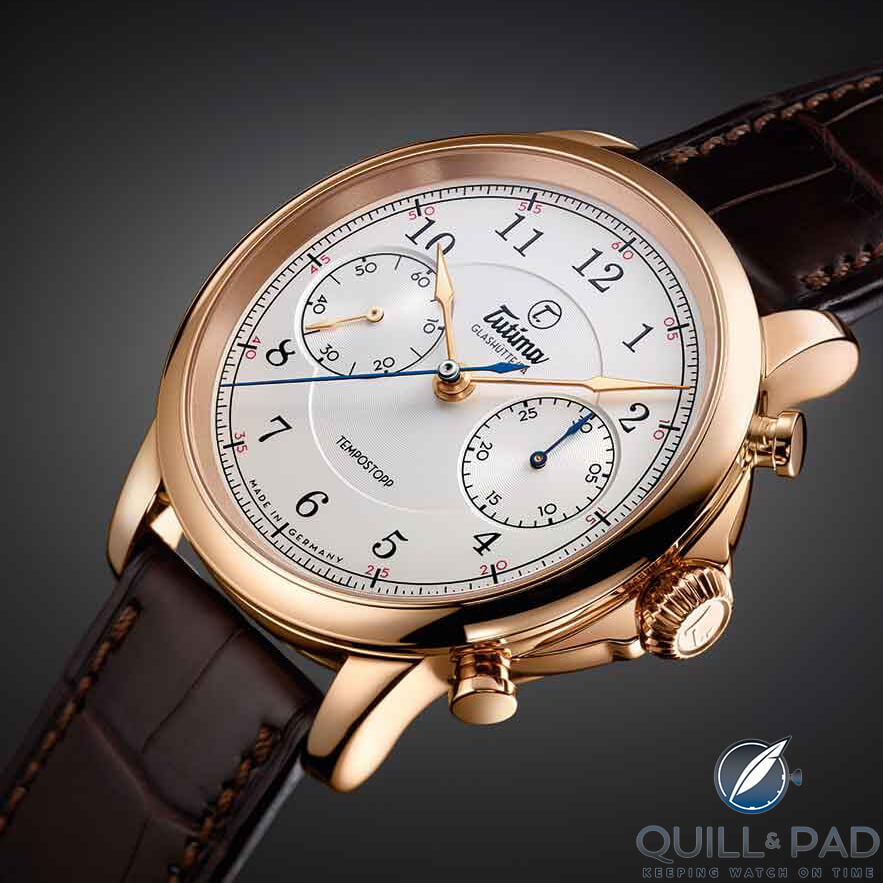
Tutima Tempostopp flyback chronograph
For more information, please visit www.tutima.com.
Quick Facts Tutima Tempostopp
Case: 43 x 12.95, 18-karat pink gold
Movement: manually wound Caliber T659, reverse-engineered and improved homage to Urofa Caliber 59, integrated chronograph with column wheel, free-sprung screw balance, hand-engraved balance cock, 21,600 vph/3 Hz frequency, 65-hour power reserve
Functions: hours, minutes; flyback chronograph with jumping minute counter
Limitation: 90 pieces (celebrating 90 years of Tutima)
Price: $29,500
Trackbacks & Pingbacks
-
[…] Tutima launched the Tempostopp, which recreated the legendary German-made Caliber 59 in a modern way, giving us the exquisite Caliber T659 (see Tutima Tempostopp Flyback Chronograph: A Moving Homage To The History Of Glashütte). […]
-
[…] For more information, please see Tutima Tempostopp Flyback Chronograph: A Moving Homage To The History Of Glashütte. […]
-
[…] Comprising 236 parts, this exquisite movement is also one of the very few “made in Glashütte” chronograph calibers. It powers the brand-new Tutima Tempostopp. […]
-
[…] […]
Leave a Reply
Want to join the discussion?Feel free to contribute!



It’s an understated, beautiful “woof piece!” 🙂
I might shed a tear too. That is a stunner.
It is, isn’t it? Thanks for reading!
Love this watch! A favorite of mine is a hand wound chrono with great movement finishing and that’s what you have here. I would prefer it in stainless steel as I’m not a fan of gold. I would prefer a stainless steel version of the original including the bezel. However I’ll take the gold :-). The movement is gorgeous!!
Any implication that it was wrong to have bombed Glasshutte when they did must be slammed immediately.
WW II was a very deadly affair for so many American soldiers and for my family members, only some of whom survived GERMAN concentration camps. Prisoners lives were more important than preserving a watch factory.
The Tutima Glashütte is watch pilot perfect for me.
Congratulations